Hair loss and baldness not only affect appearance and self-esteem, but also cause many people to feel less confident in communication, work, and relationships. To completely address this issue, a hair transplant is an ideal solution, helping you achieve thicker, healthier hair and significantly improve your appearance. So, what is a hair transplant? How does a hair transplant work? Let’s explore the details right here!
What is a hair transplant?
Hair transplant surgery is a cosmetic procedure used to treat hair loss and baldness by relocating hair follicles from areas with healthy hair called the donor area, to balding or thinning areas, known as the recipient area. Typically, the donor area is located at the back of the scalp or on the sides near the temples. This procedure must be performed by a qualified dermatologist or cosmetic surgeon, someone with high expertise and experience in hair transplant.
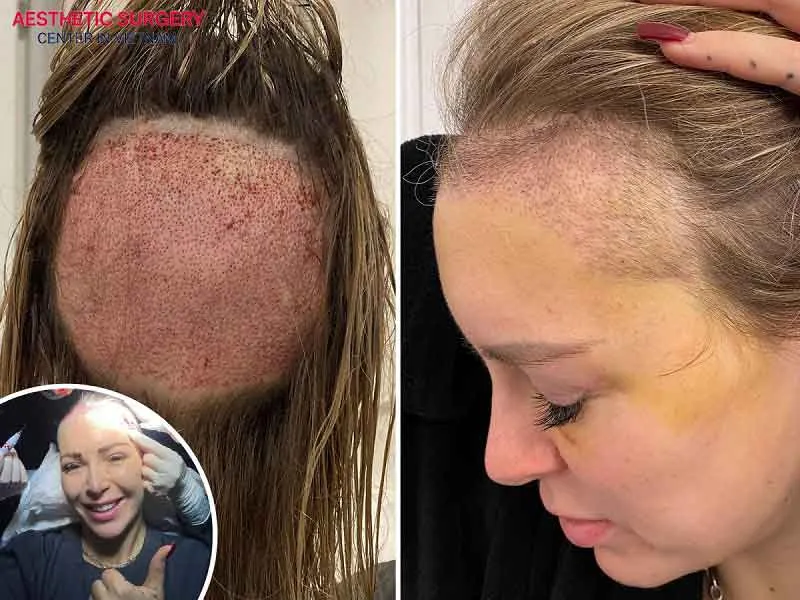
Benefit of hair transplant
For many people, hair transplant is a “lifesaving” solution, especially after trying various treatments for hair loss or baldness, such as medication, specialized shampoos, or laser therapy, without achieving the desired results. Hair transplant procedures in Vietnam offer numerous advantages, including:
Restoring thick hair, enhancing aesthetics and confidence
This is one of the biggest benefits of hair transplant in Vietnam, highly valued by many individuals. With modern hair transplant procedures, doctors are able to implant hair follicles following the natural direction and density of your hair, resulting in a look that is completely natural, virtually indistinguishable from real hair. After the procedure, new hair grows in full and healthy, helping you appear younger, more energetic, and more confident in social and professional settings.
Naturally growing hair that’s easy to care for
If you undergo an autologous (self-donor) hair transplant, the doctor uses your own healthy hair follicles, typically from areas with good hair growth, and implants them into thinning or bald areas. These follicles will grow naturally because they are, in fact, your real hair. You can wash, cut, brush, dye, and style them just like your original hair with no complications. In addition, the transplanted hair blends seamlessly with your existing hair, offering a natural and comfortable result.
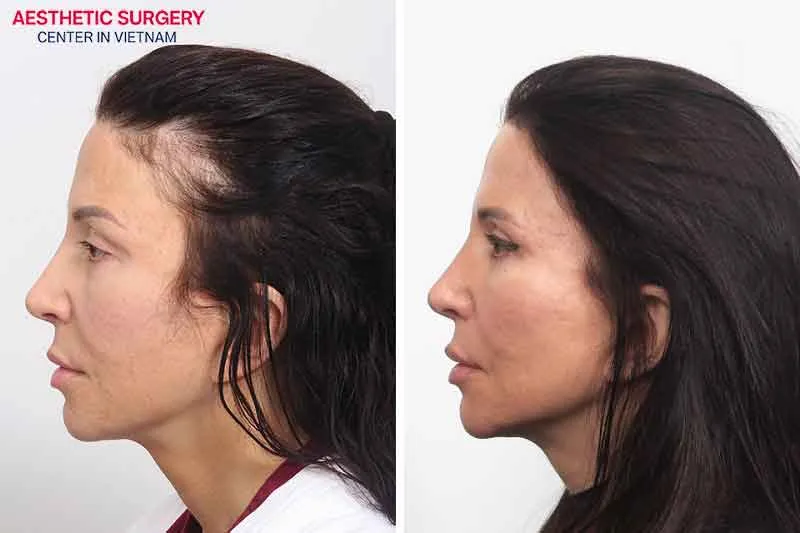
Addressing multiple hair issues
Hair transplant is an effective solution for various hair-related problems in both men and women, such as thinning hair, baldness, and hair loss caused by genetics, trauma, or burns. After undergoing a hair transplant, these conditions can significantly improve within just a few months, resulting in thicker, fuller, and more natural-looking hair.
Long-lasting, sustainable results
Unlike temporary at-home treatments for hair loss like topical or oral medications, hair transplant offers near-permanent results. The hair follicles extracted from the donor area are typically healthy and resistant to the hormone DHT. When implanted into the recipient area, these follicles retain their resistance and continue to grow naturally and healthily for a long time, often for life.
Safe, minimally painful, low risk of complications
Autologous hair transplant is considered a safe procedure by medical experts, carries a low risk of rejection, is minimally invasive, causes little discomfort, and allows for a relatively quick recovery. Therefore, if you are experiencing bald spots or thinning hair, you may want to consider undergoing a hair transplant in Vietnam.
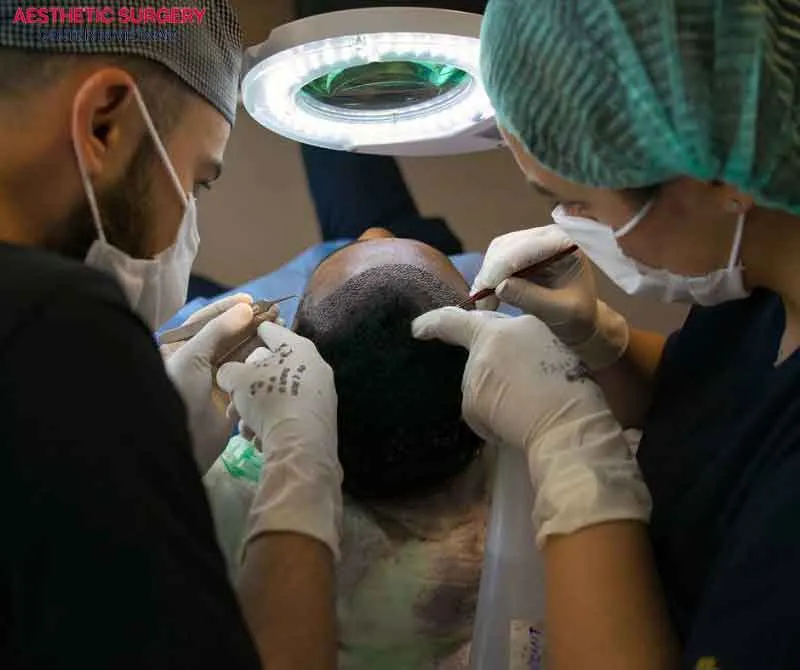
Who is a candidate for hair replacement?
Although hair transplant offers many benefits, it is not suitable for everyone. The following individuals are considered the most appropriate candidates for this procedure:
- People aged 23 – 25 and older.
- Those with good overall health, not suffering from serious chronic illnesses such as bleeding disorders or uncontrolled diabetes
- Individuals experiencing hereditary baldness, in both men and women.
- Those who have a healthy donor area with a sufficient number of hair follicles, especially in the nape of the neck or temporal regions.
- People whose hair loss condition has stabilized.
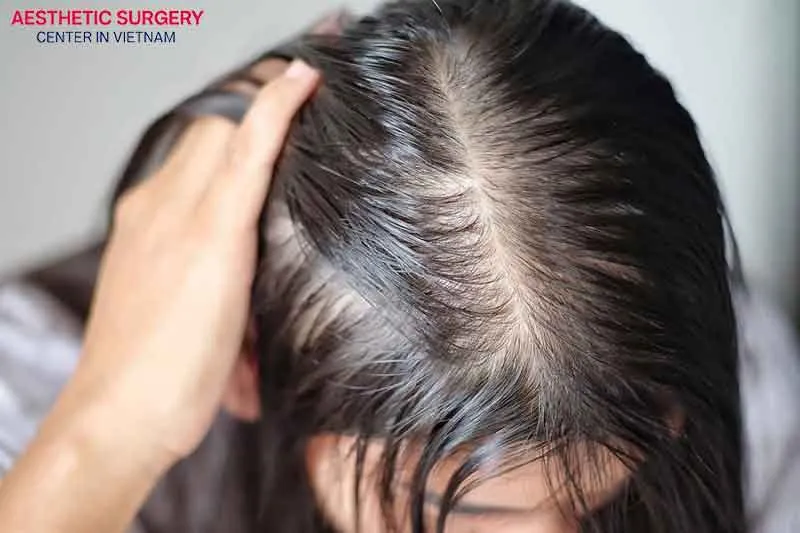
What are the types of hair transplant procedures?
Currently, there are two main hair transplant procedures widely used: Autologous hair transplant and Artificial hair transplant. Among them, autologous hair transplant is more commonly applied and preferred due to its high safety and long-lasting results. Here’s a detailed breakdown:
Autologous hair transplant
This procedure uses the patient’s own healthy hair follicles, typically harvested from the nape area or temples, and transplants them into bald or thinning areas. The transplanted hair continues to grow naturally over time. Autologous hair transplant is further divided into the following methods:
- FUE hair transplant: FUE stands for Follicular Unit Extraction. In this procedure, the doctor uses a specialized tool with a very small diameter (about 0.6 – 1.0 mm) to extract individual hair follicles directly from the donor area. Then, these follicles are implanted into small incisions that have been pre-created in the recipient area. The advantages of this procedure are that it does not leave long scars, is minimally invasive, causes little pain, has a quick recovery time, and provides natural results. However, the FUE procedure usually takes quite a long time and requires transplanting a large number of follicles, and the price is high.
- FUT hair transplant: FUT stands for Follicular Unit Transplantation. To perform this procedure, the doctor removes a strip of scalp containing many hair follicles from the donor area (usually the back of the head). This strip is then divided into individual follicular units under a microscope and transplanted into the recipient area. The advantage of FUT is that a large number of follicles can be transplanted in one session, the procedure time is faster than FUE, and the price is lower than FUE. However, this procedure leaves a fairly long scar, may cause more pain and swelling, and requires a longer recovery time.
- DHI autologous hair transplant: DHI is a variation of FUE, in which the doctor uses a specialized tool called the DHI implanter pen, known as the Choi Implanter Pen, to directly implant hair follicles into the scalp without the need to create incisions beforehand. The follicles are extracted and immediately implanted into the recipient area. The strengths of the DHI procedure include better control over the angle, direction, and depth; increased survival rate of the follicles; minimal scalp damage; and faster skin recovery. However, DHI requires highly skilled doctors to perform and is the most expensive among hair transplant procedures.
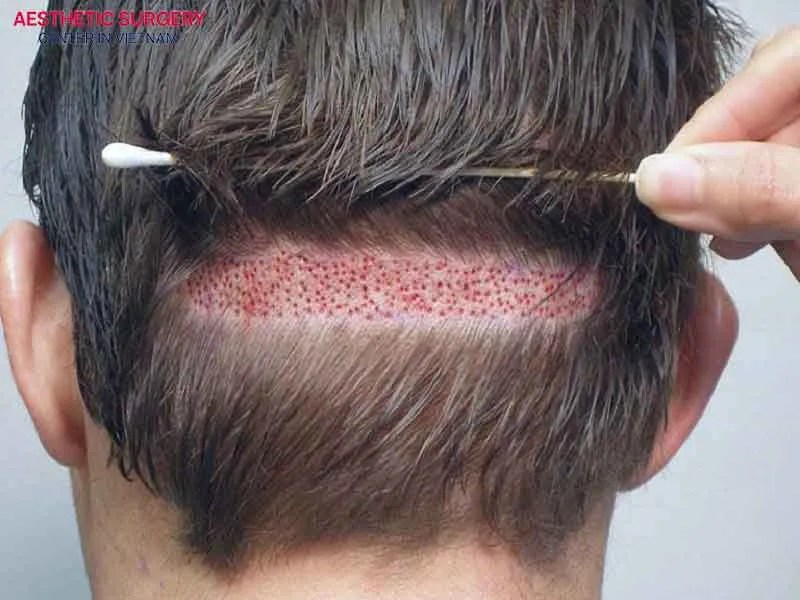
Artificial hair transplant
Artificial hair transplant is a procedure that uses artificial hair strands made from biocompatible materials to be implanted directly into the scalp.
Advantages:
- Hair density is immediately improved after implantation.
- Suitable for those who do not have enough natural donor hair.
- Less painful compared to an autologous hair transplant.
Disadvantages:
- High risk of rejection and infection.
- Not real hair, cannot grow, be cut, dyed, or styled like natural hair;
- Artificial strands may break or become damaged over time, requiring periodic replacement.
- Aesthetic results may not be as natural as with an autologous hair transplant.
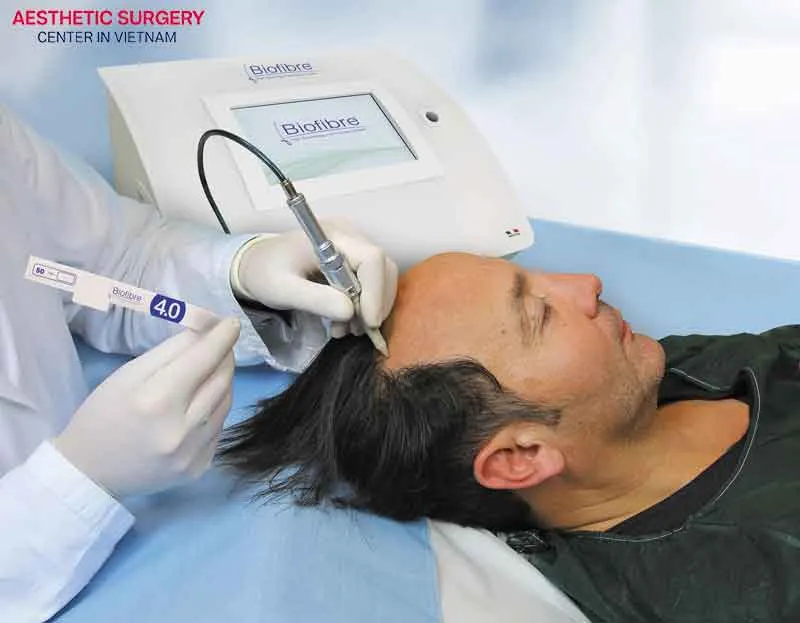
How does a hair transplant work?
Similar to other cosmetic surgery procedures, the hair transplant surgery process consists of several steps, from preparation to post-operative care. Specifically, the hair transplant procedure includes the following:
Step 1: Examination and consultation
In the first step of the hair transplant process, the doctor will check the hair loss condition, the degree of baldness, and the quality and density of hair in the donor area. After identifying the cause of hair loss, the doctor will discuss with you the number of grafts needed, design a new hairline, choose the appropriate procedure, and finally perform blood tests to ensure you are in good health for surgery.
Step 2: Shaving, cleaning and sterilization
Depending on the procedure, the doctor will require shaving in the donor and recipient areas. For FUE, both the donor and recipient areas will be shaved short to allow the doctor to extract and implant hair follicles more easily. For FUT, the doctor only needs to shave a small strip of the donor area.
Then, the doctor will clean and disinfect the scalp areas to prevent infection.
Step 3: Local anesthesia
To ensure the patient feels no pain, remains comfortable, and stays conscious during the procedure, the doctor will inject local anesthesia into both the donor and recipient scalp areas.
Step 4: Follicle extraction
Depending on the procedure, the doctor will extract follicles using different techniques:
FUE procedure: The doctor uses a specialized punch tool with a small diameter to directly extract individual follicular units (each containing 1–4 hairs) from the donor area. These are then carefully preserved in a special solution to maintain viability.
FUT procedure: The doctor cuts a rectangular strip of scalp from the donor area (usually the back of the head). This strip is then handed over to a specialized technician team to divide it into small follicular units under a microscope. The donor area is then sutured.
Step 5: Creating incisions in the recipient area
The doctor will use specialized tools such as needles or micro blades to create tiny incisions in the bald or thinning recipient area. This step requires precision to ensure the correct angle, direction, and density for natural hair growth.
Step 6: Implanting hair follicles
After the incisions are made, the harvested follicles will be carefully implanted into the created sites. The doctor ensures that each graft is placed in the correct position and depth to maximize survival and hair regrowth.
Step 7: Post – operative care
After the hair transplant procedure, the doctor will bandage the scalp area, depending on the condition. You will then be given detailed instructions on how to care for the transplanted area at home, including how to gently wash your hair, use antibiotics, pain relievers, and anti-inflammatory medication, avoid vigorous activity and UV exposure, follow a proper diet, and attend follow-up appointments.
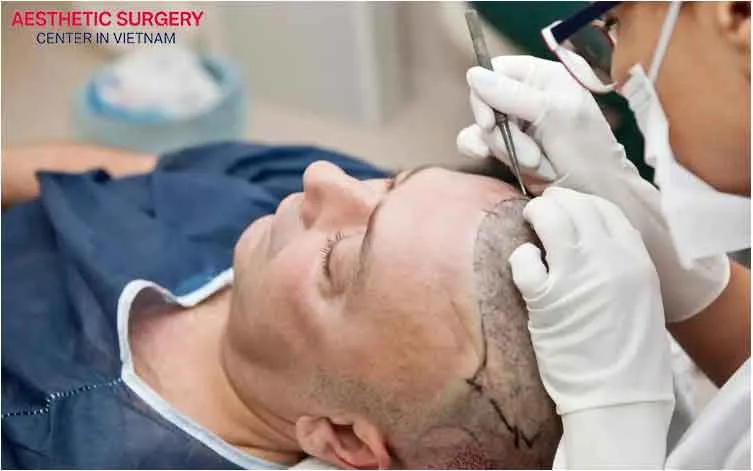
What is the recovery process after hair transplant surgery?
After undergoing hair transplant in Vietnam, the transplanted follicles will go through important recovery and growth phases. You can monitor these stages to care for your scalp properly and avoid unexpected risks:
Initial recovery phase: First 1 – 2 weeks after transplant
The transplanted scalp area may experience mild swelling, redness, and small scabs. This is normal and will soon subside. During this time, you should keep the bandage in place as instructed by the doctor and use pain relievers, antibiotics, and anti-inflammatory medications to prevent infection and reduce swelling. Also, take note of the following:
- Avoid touching the transplanted area to protect the newly implanted follicles that have not yet firmly attached.
- Do not wash your hair within the first 24–48 hours.
- Eat soft, easy-to-chew foods like porridge or soup.
- Avoid foods such as alcohol, beer, tobacco, coffee, green tea, soft drinks, chicken, beef, seafood, spicy, oily or greasy dishes to prevent itching, pus, swelling, and irritation.
- Take painkillers and anti-inflammatory medications as prescribed.
- In the first nights after the transplant, sleep on your back with your head elevated to reduce swelling and avoid pressure on the transplanted area.
- Avoid strenuous activity and excessive sweating.
- Refrain from wearing tight hats or pulling clothing over your head to avoid damaging the transplanted area.
- From day 7 to 14, scabs will begin to fall off. Do not scratch or peel the scabs. You may use hair care oils as instructed by your doctor to reduce itching and nourish the scalp.
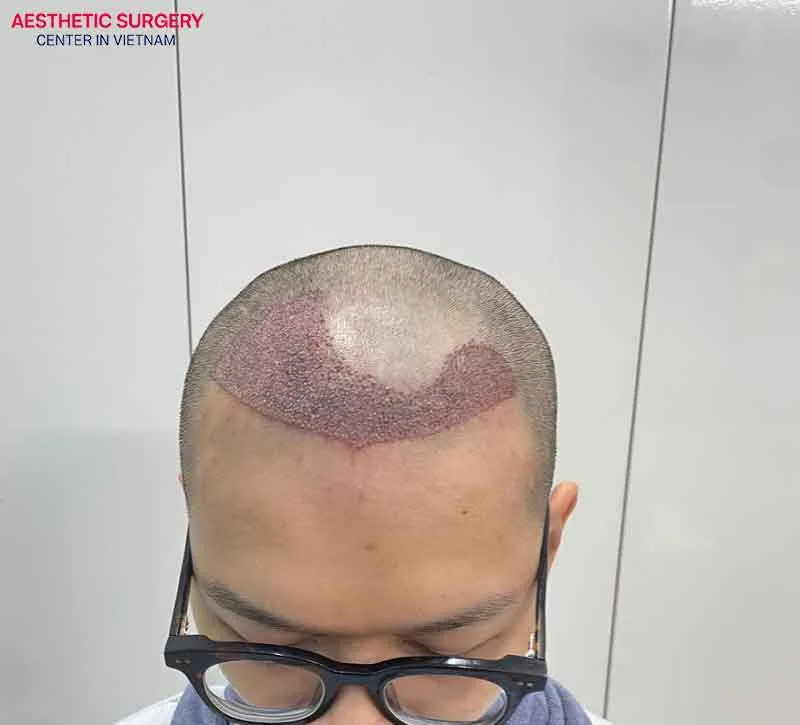
Hair shedding and regrowth phase: 1 – 6 months after transplant
After the first 4 weeks, the hair follicles are firmly attached to the scalp, and some transplanted hairs may fall out. This is known as shock loss and is completely normal. It signals that the follicles are adapting and preparing for a new growth cycle. You can return to your normal activities, but take care to avoid sun exposure, dust, and wearing helmets during this time.
After 2 – 3 months, shedding of the initial hairs may continue. New hair will begin to grow back, initially appearing as soft, fine, and sparse strands. Growth may be uneven and coverage still limited.
However, by 3 – 6 months, most of the transplanted areas will begin to grow new, stable hair that starts to lengthen. You’ll begin to see the results of the transplant, although the hair is still thin and not yet as dense as desired.
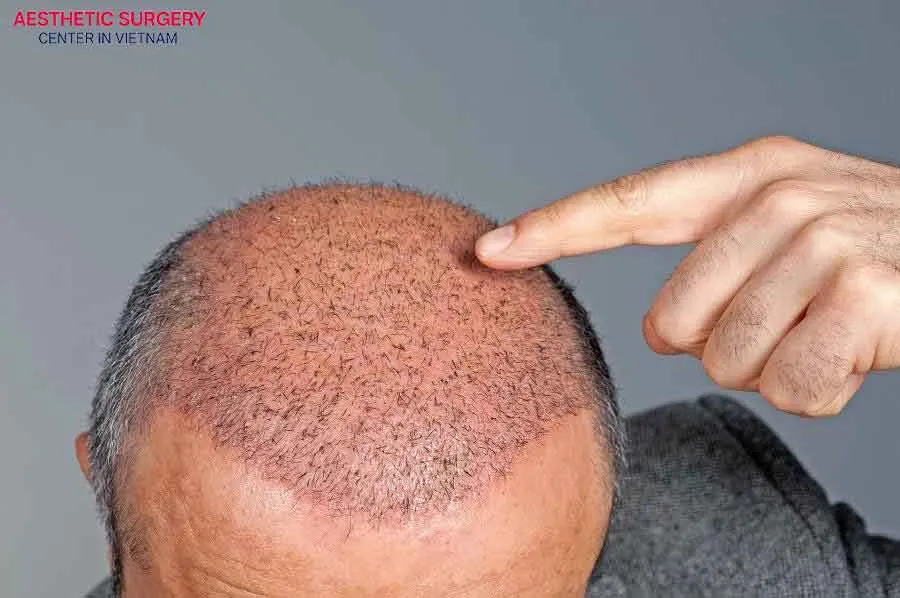
Mature hair growth and final results: 6 – 18 months after transplant
From month 6 to month 9, hair becomes thicker, shinier, and grows significantly, more than 20 cm depending on individual condition. Around 50–70% of transplanted hairs will have grown and developed. Between months 9 and 12, the hair will grow steadily and naturally, becoming denser, with nearly 90% of the transplanted hair visible. At this point, the hair is long enough for you to style as desired.
Finally, between 12 and 18 months after your hair transplant in Vietnam, the final result will become most evident. The transplanted hair will have fully matured, grown strong and thick, and blended seamlessly with your natural hair. At this stage, you can shampoo, curl, or dye your hair normally, but for safety, consult your doctor before doing so.
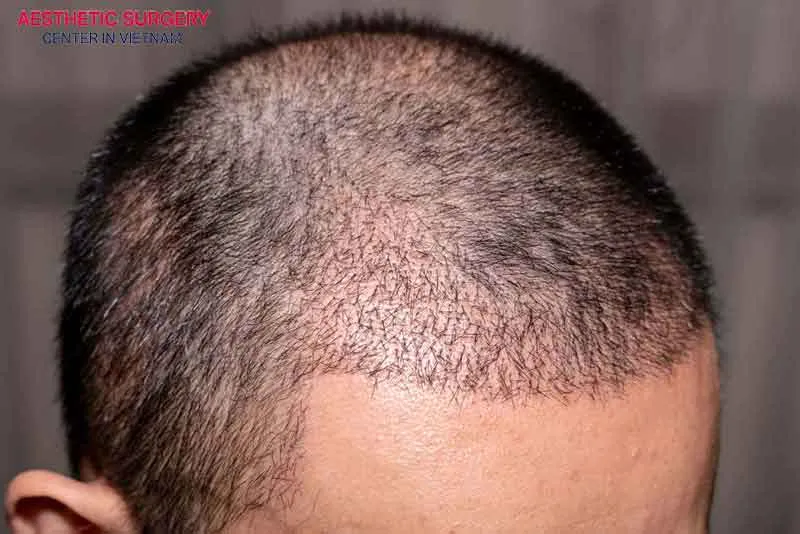
Hair transplant before – after
To witness the remarkable transformation before and after hair transplantation in Vietnam, you can take a close look at actual clients who have used the service:
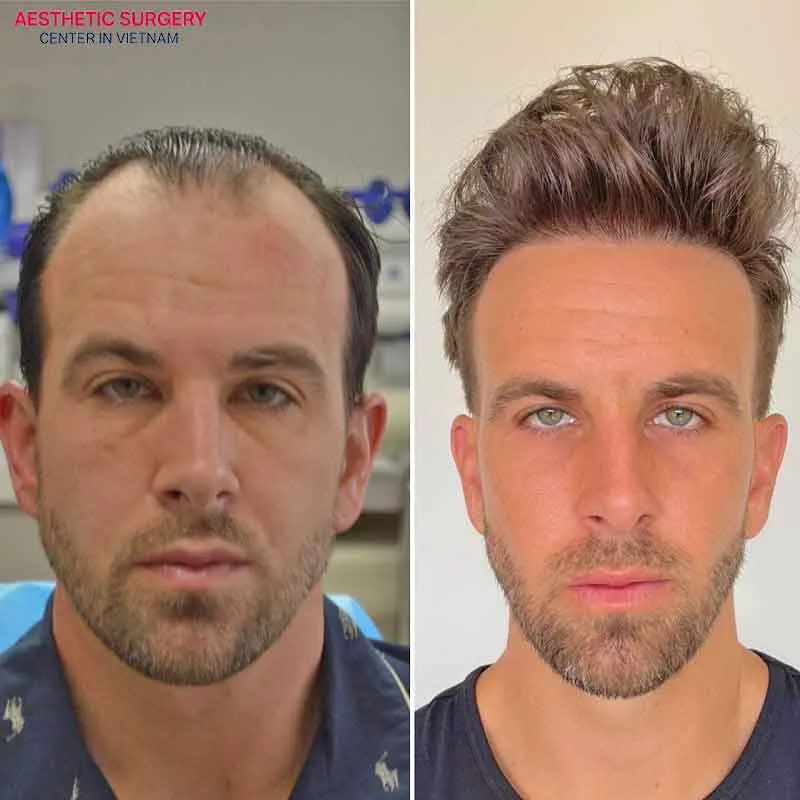
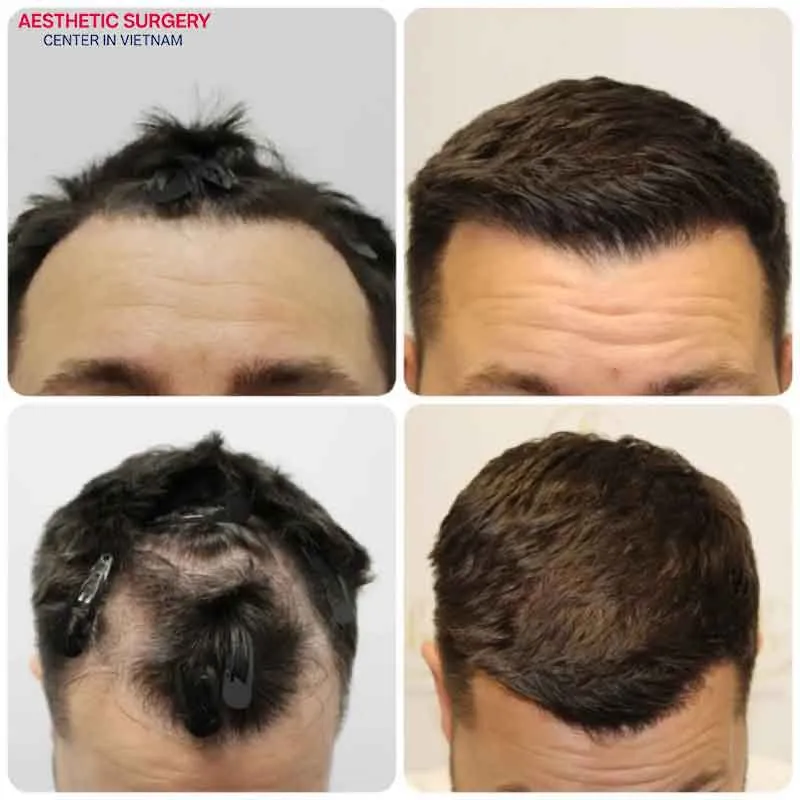
Aesthetic Surgery Center – Hair transplant in Viet Nam
Hair transplant is a fairly complex cosmetic surgery procedure that requires high precision and must be performed by skilled, highly qualified, and experienced cosmetic surgeons, supported by modern medical equipment and technology. Therefore, if you are dealing with issues such as hair thinning or baldness and are considering a hair transplant, make sure to thoroughly research and select a reputable aesthetic facility. Aesthetic Surgery Center is one of the ideal choices for the following reasons:
- Aesthetic Surgery Center applies advanced hair transplant technologies: Currently, Aesthetic Surgery Center owns the most advanced hair transplant technologies such as FUE and DHI, helping clients achieve thick, strong, and beautiful hair after transplantation. These technologies are highly rated for their safety, minimal invasiveness, no visible scarring, quick recovery time, and especially high precision that allows hair follicles to grow in the correct natural direction. The transplanted hair grows normally and maintains long-term results.
- Experienced team of cosmetic doctors in hair transplantation: Aesthetic Surgery Center has a team of highly qualified cosmetic doctors trained at prestigious medical schools, with deep and extensive experience in the aesthetic field. In particular, they have successfully performed countless hair transplant procedures for clients. Therefore, doctors here will help you restore thick, healthy hair.
- Absolute safety for clients’ health: Aesthetic Surgery Center always adheres to strict medical standards such as: sterile operating rooms and instruments according to Ministry of Health standards to prevent infection and cross-contamination. In addition, the entire process here follows medical protocols, doctors conduct thorough health exams, perform general health testing, and provide post-operative care instructions, all done professionally to minimize risks and complications.
- High success rate, natural aesthetic results: The experienced doctors at Aesthetic Surgery Center perform the extraction and transplantation of hair follicles with precision and care, ensuring that the follicles are preserved intact and have a survival rate of up to 95% after implantation. Moreover, the doctors know how to implant hair at the appropriate density to cover bald areas while ensuring sufficient blood supply, helping the hair grow strong and thick. Therefore, clients can feel confident when undergoing hair transplant at Aesthetic Surgery Center, thanks to the high success rate and satisfactory aesthetic results.
- Thoughtful post-operative care: Post-transplant care greatly affects the final result. Hence, if the aesthetic facility provides good post-op care, the chances of success will be much higher. At Aesthetic Surgery Center, after the procedure, you will be given detailed instructions by doctors or nurses on how to care for your scalp at home, including how to wash your hair, eat, and live to ensure quick healing and healthy follicle growth. Additionally, the doctor will schedule follow-up visits to monitor hair growth, promptly address any issues if they arise, and the center’s support team is always available to assist and answer your questions at any time.

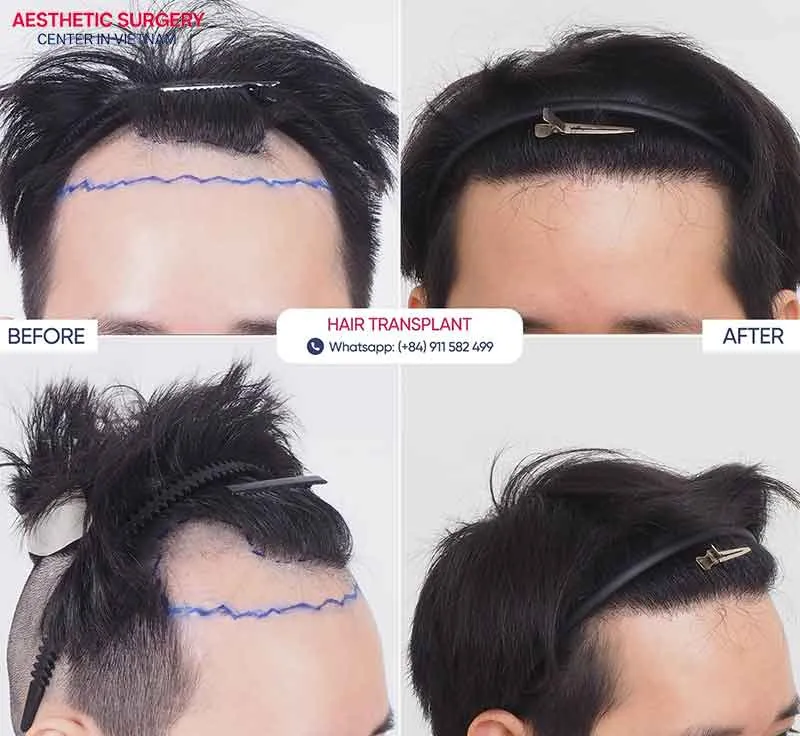
With the outstanding advantages that Aesthetic Surgery Center offers, you can feel confident using their hair transplant services without worrying about service risks. Contact us via hotline 0911 582 499 if you would like to book an appointment or need consultation about the procedure.
It can be said that hair transplant is an extremely effective cosmetic surgery method to improve thick and healthy hair, suitable for both men and women, especially those suffering from baldness or thinning hair. However, service users need to choose a reputable aesthetic facility to ensure effective and safe hair transplant and avoid unwanted complications.







Comment on the post